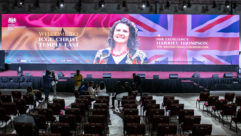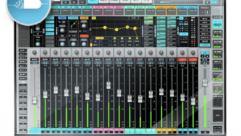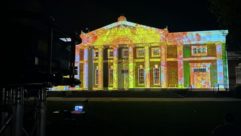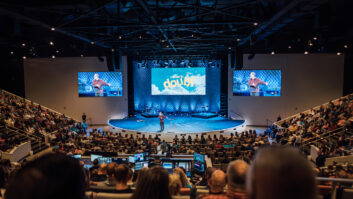PRECISION TURNING
Dec 1, 1998 12:00 PM,
Leslie McLeod
The use of computer modeling in the design process of room acoustics andsound systems has become standard practice for many designers. At thebeginning of the decade, four major programs were available fromloudspeaker manufacturers. One of the programs was withdrawn from themarket for the in-house use of the manufacturer, and the other threeprograms have been combined in various ways into the upcoming version ofEASE for Windows.
EASE has now become the standard for evaluating loudspeaker and roomtreatment performance during the design stage. The companion program, EARS,provides the capability to audition the results from the model by playingback convolved audio files or convolving in real time with additionalhardware from Lake DSP. The current DOS-based programs are veterans ofseven years of use by contractors and consultants. Over this time, thepredicted data has been compared to measured data in countless projects,leading to confident predictions that allow consultants and contractors toprovide detailed, timely information to the architectural design team.
In the past few years, the development of the software has focused on a new32-bit version (V 3.0), anticipated for release early in 1999. Currentusers still work with the rather dated-looking DOS (16-bit, V 2.13) versionof the program. This may lead people to believe that the current program islimited in the scope of projects that can be handled by the software. Oncloser examination, however, these DOS versions of both EASE and EARS havethe power to handle even the largest buildings and provide an intricatestudy of the performance of sound systems and room acoustics.
All of the major loudspeaker manufacturers have developed EASE data fortheir installation-oriented loudspeaker models. This, in turn, has evolvedover the years into a comprehensive catalogue of loudspeakers that offerthe designer the ability to compare performance and check compatibility ofalternates in a manner unparalleled in any other current software platform.The concise nature of the data files also allows the most current devicesto be available on the Internet for efficient downloading. While the AESstruggles with developing a format for the next generation of loudspeakermodeling data, contractors can make use of the current data in a practicalmanner. The analysis of projects that have been completed to date indicatesa high correlation between the modeled data and data measured on site.Loudspeaker aiming, cluster element balancing and signal delay settingsoften require little or no adjustment if the installation was able toreflect the modeled locations for devices accurately. Clearly, this aspectof the process requires a good understanding of the practical limitationsof installing loudspeaker components in an array. Mechanical informationgoes well beyond the data provided by any acoustical modeling software.
A limitation of 16-bit software involves the ability to address theextensive hardware resources of the latest PCs. This is most strongly feltin the way the programs access memory, being limited to only the first 1 MBof RAM. The software will run under Windows 95 and 98, however, even onFAT32-formatted disks. The programs can also take advantage of the higherclock speeds offered by the latest processors, greatly increasing the speedof such complex tasks as ray tracing and convolution.
EASE is supplied with a series of room templates that cover many of thecommon room shapes encountered in general practice. These can beinteractively modified to suit the specific dimensions of a project, or themodel can be built from scratch. Once the basic envelope is created,details can be quickly added to the room, such as doors, windows, stairwaysand railings. Following a basic rule of thumb whereby any surface detailthat is 10% or more of the total surface is modeled, the designer cancreate an effective acoustical model that reflects the primary acousticalissues without getting too involved in architectural detailing. After all,the intention is to create a model with enough detail to guide the design.It is unnecessary to place too much detail in the model because surfaceeffects-diffusion and diffraction-cannot be calculated within the currentsoftware anyway. The model should always be regarded as a rendering of theroom interior and not a photograph of the finished room. The designer mustalways keep in mind that there are not only practical limitations to thedetail of calculation, but also inevitable changes made on site duringconstruction. The 10% rule seems to be sufficient for gathering conciseinformation while avoiding a purely academic study of the design. Theprogram can handle surprisingly complex rooms. Functional EASE models havebeen created with more than 1,200 surface planes defined, but it is morecommon to work with models with 100 to 300 faces.
Handy tools within the program, such as edges, offer the user a method forderiving accurate locations for complex intersections between surfaces,such as walls and sloping ceilings. Using the edge as a form of chalk line,the user can find the exact location of the intersection. This specificinformation is often unavailable from the plan and section drawingsprovided by the architect. The cut command provides a quick way to increasethe number of planes describing a surface. This is often the fastest way tocreate the necessary flat planes on a complex surface, by reducing thesurface to a series of triangles. Thus, the user can sidestep the dreaded”face is not a plane” error that can arise when modeling complicatedsurfaces.
The need to model surface treatments that overlay parts of a surface, frompews in a church to acoustic treatments on the ceiling, is accommodated bythe addition of a coat to the face. The coat acts as a 3-D surface,floating just off the face, which can be modified to provide specificacoustical behavior. This should not be confused with the acoustic paintthat seems to appear only in architectural concepts and not in acousticalreference books. The program includes a number of complete catalogues ofacoustical materials to select from, in addition to the facility to enterthe user’s own acoustical material data.
Ray tracing is a primary function of the program that allows the behaviorof room finishes and loudspeaker systems to be examined in great detail.The program offers a number of methods for this analysis; typically theimpact mode is used to study the acoustical behavior between sound sourceand listener. The program calculates the number of rays (a single point inthe wavefront emitted from a sound source) that reach the listener from aspecific sound source or combination of sources. This is a statisticalstudy of the room acoustics where a random series of rays are emitted fromeach source based on criteria determined by the user. In large, complexrooms, ray tracing can be a time-consuming process. A recent project hadmore than 750 faces in a large asymmetrical room, and the ray tracingproceeded at approximately 100,000 rays in every 24 hours of calculation ona Pentium II running at 300 MHz. The number of faces within the model willhave a major impact on rate of these calculations. Typically, models willhave less than 300 faces, and ray tracing will proceed far more quickly,often by several orders of magnitude.
After the ray tracing is complete, the resulting reflectogram is analyzed,and EASE will output a file containing the parameters necessary to auralize(listen to) the model. The resulting post file is then processed within theEARS program to derive a stereo 3-D representation of the sound qualitiesof the room and loudspeaker system. EARS uses data from the model combinedwith a head-related transfer function to create audible renderings of thecomputer model. These renderings can be applied to pre-recorded sounds inthe form of a WAV file or transferred to a SIM file for use with a Lake DSPengine. The Lake CP4 or Huron DSP engines offer the capability of speakinginto a live mic and listening to the room with only a few milliseconds ofprocessing latency.
The auralization of computer models provides a practical method of bringingacoustical issues into sharp focus. Many acoustical problems encountered inthe design of buildings are too esoteric for the architect and owner tounderstand clearly. When these issues are made audible through the processof auralization, however, they can quickly bring the design team togetherin an effort to address the problems. Although far from a literal recordingof the sound in the space, the auralization is able to highlight specificproblems and place them within earshot of the design team and buildingcommittee. The EASE/EARS process includes aspects of the loudspeakersystems’ (along with a selection of human voice parameters) performance sothat different array configurations can also be auditioned.
The EARS program has proved capable of auralizing large reverberant spaceseffectively. Limitations in access to RAM and practical ray tracingcurrently restrict the program to reverberation times of approximately 4seconds to 6 seconds, but hybrid techniques, using calibrated externalreverberation generators, can offer listeners the opportunity to hearreverberation times that extend two to three times longer. The result is amethod of listening to comparative studies of a variety of acoustictreatments (or lack thereof) that can be beneficial in the design stage ofa building project.
Although still laboring in the antiquated operating parameters of MS-DOS,both EASE and EARS provide practical tools that can be applied to a widerange of projects. From an analysis of the benefits of a loudspeakerupgrade to the complete acoustic design of a music venue, these twoprograms offer a wealth of information that has an established practicalapplication in the field. The essential training in the use of thesepowerful programs is provided by both the program’s internationaldistributor, Renkus-Heinz, and by Telex Communications for its own dealernetwork.
A number of PC-based computer programs are currently available that providethe ability to predict the performance of a virtual sound system design ina virtual room. Most also provide some ability to predict the acousticalresponse of a virtual room. It should be noted that these programs can beused either as design tools or marketing aids. These programs, as effectivedesign tools, are different from the marketing presentation aid ormuch-hyped guaranteed sound predictor.
When predicting sound-system performance, data from predictive programs arecommonly displayed by a coverage map or frequency-response chart. In bothcases, there are well-known tolerances that can be used to evaluate thesuccess of the virtual design. An example would be the variation in levelof the coverage of a cluster of loudspeakers. The variation of level mightbe examined for a given frequency range at several positions across aseating area or for various frequencies at one listening location. Ineither case, large variations often suggest problems, a fairly direct wayto determine the success of the design. It should be noted that manycoverage map calculations do not include time domain interactions ofsources (for example, complex array performance) in the calculation,limiting accuracy of the prediction.
With acoustical design calculations, the problem is more complex. The firstcomplication is that there is a distinction between the behavior ofacoustically large and small rooms. Small rooms, where modes can dominatethe low-frequency response (approximately 20 Hz to 300 Hz), require adifferent set of calculations than large rooms where reflections andsemi-diffuse energy typically dominate the response and decay. Recently, anumber of programs that address the acoustics of small rooms have enteredthe marketplace, but these are most accurate for geometrically simple rooms.
To predict the behavior of acoustically large rooms, the most commoncalculations are attempts to follow the path of sound from a sound source(or sources) reaching a particular listener position and statistical modelsof the diffuse or reverberant decay. Both have limitations. Additionally,the ability to calculate the absorption and diffusive properties ofsurfaces accurately or even draw extremely complex shapes also limits theaccuracy further. Understanding the limitations of these calculations iscritical in using acoustical predictive programs most effectively.
In the design process, once you have drawn a virtual room and selected asource and listener position, how does one evaluate the results of thepredictive calculations? The first type of acoustical calculations oftenpresents a series of arrival times of reflections of sound. Thesereflections are typically calculated using either an image or raytracing(or hybrid) algorithm. In the simplest case, the distribution of arrivalsof reflections can be examined for either a single or multiple listenerlocation. The number of reflections reported is commonly a function of thegeometry of the room and the order of the calculations used. The order ofthe calculation represents the number of surfaces that sound has bouncedoff. Typically third-, fourth- or fifth-order calculations are performed.Higher order calculations can require a long time to calculate and havereduced accuracy because effects such as diffraction and diffusion becomemore important for higher order sound/surface interactions.
Comparing the results of sound-path calculations for several listeningpositions for a given source location within a virtual room can be a usefuldesign aid. Further, comparisons of these virtual results with results fromcomputer models of existing rooms (with acoustics that are consideredsuccessful for a given purpose) can reveal such anomalies as reflectionsisolated in time or unusual grouping of reflections. In most cases,radically different results in similar positions within a virtual room-suchas two seats in the same row-can indicate a problem with the room’sgeometry. Notice that there is no simple set of tolerances-analogous to thechange in level of a coverage map-that can be applied to the acousticalprediction of the distribution of reflections.
Recently, the ability to take the results of acoustic sound-pathcalculations and createaudible simulations has become practical for PCs.Creating an audible simulation of the results of sound-path calculationscan be useful to help compare results from different source and listenerpositions in a virtual room or for models of existing rooms. Although thesesimulations may not sound like the final, actual room, creating an audiblesimulation that includes only the early reflections (typically the first250 ms) but does not include the diffuse-reverberant tail can help inhearing the character of the room’s tone.
When evaluating the diffuse energy calculations of a virtual room, mostprograms report predicted reverberation times based on statisticalcalculations. One can use a series of optimum reverberation timetables todetermine if the prediction of the virtual room’s reverberation time meetsthis criteria. Although many people find this a useful technique, I believeit has limited usefulness as a design tool. It is important to note thatmost statistical calculations assume that the room has a simple geometryand a completely diffuse energy field exists, both of which are rare in thereal world.
It is important to remember that statistical models provide only limitedinformation about the actual sound of a room. Two rooms with identicalreverberation-time spectra can sound radically different, which is mostcommonly attributable to the presence or lack of discrete reflections.Unless the predicted reverberation times are far outside reasonable values,these statistical calculations have only a limited value. One way thatstatistical calculations can be examined to help evaluate the design islooking at the ratio of decay rates at various frequencies across theaudible spectrum. This comparison can help determine if a room lackssufficient low-frequency control, a common problem that can result inrooms’ being described as “boomy.” It is a critical step, when trying todetermine the success of a design, to consider both the statistical resultsand the distribution of reflections.
In summary, all of the programs currently available have limitations interms of providing accurate predictions of the acoustics of rooms andsound-system performance. The ability to compare the approximationsgenerated from these programs for several positions within a virtual room,or comparing your design with virtual models of existing rooms, however,can be helpful in your designing stage.










